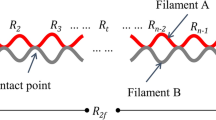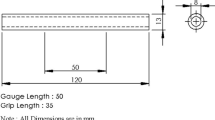Abstract
Tests of cross-ply composite tubes were performed under combined axial and torsional loading up to failure. Strength properties and failure mechanisms were evaluated with reference to the biaxiality ratio of the loading. The scattering of the biaxial strength data was analyzed using the Weibull distribution. The axial contraction of carbon fiber-reinforced plastic (CFRP) tubes under biaxial loading was investigated theoretically and experimentally. Artificial neural networks were introduced to predict the failure strength using the algorithm of the error back-propagation. The prediction was also made by the Tsai-Wu theory using the experimental data and by the combined optimized tensor-polynomial theory. A comparison shows that the artificial neural network has the smallest root-mean square (RMS) error of the three prediction methods. The prediction of the axial contraction of the tubes correlates well with the results of a linear variable differential transformer (LVDT) of the testing machine. From the phenomenological analysis of the failure and the fractographic observations of the fracture surface, three types of failure modes and microscopic failure were investigated, depending on the biaxiality ratio, and the corresponding failure mechanisms are suggested.
Similar content being viewed by others
References
P. D. Soden, R. Kitching, P. C. Tse, Y. Tsavalas, and M. J. Hinton, „Influence of winding angle on the strength and deformation of filament-wound composite tubes subjected to uniaxial and biaxial loads,” Compos. Sci. Technol.,46, 363–378 (1993).
J. Mistry, „Theoretical investigation into the effect of the winding angle of the fibres on the strength of filament wound GRP pipes subjected to combined external pressure and axial compression,” Compos. Struct.,20, 83–90 (1992).
S. R. Swanson, M. J. Messick, and Z. Tian, „Failure of carbon/epoxy laminates under combined stress,” J. Compos. Mater.,21, 619–630, (1987).
S. Amijima, T. Fujii, and M. Hamaguchi, „Static and fatigue tests of a woven glass fabric composite under biaxial tension-torsion loading,” Composites,22, 281–289 (1991).
T. Fujii, S. Amijima, and F. Lin, „Study on strength and nonlinear stress-strain response of plain woven glass fiber laminates under biaxial loading,” J. Compos. Mater.,26, 2493–2510 (1992).
D. Purslow, „Some fundamental aspects of composites fractography,” Composites,12, 241–247 (1981).
B. W. Smith and R. A. Grove, „Determination of crack propagation direction in graphite/epoxy structures,” in: J. E. Masters and J. J. Au (eds.), Fractography of Modern Engineering Materials: Composites and Metals, ASTM STP 948 (1987), pp. 154–173.
M. F. Hibbs and W. Bradley, „Correlations between micromechanical failure processes and the delamination toughness of graphite/epoxy systems,” ibid, in: J. E. Masters and J. J. Au (eds.), Fractography of Modern Engineering Materials: Composites and Metals, ASTM STP 948 (1987), pp. 68–97.
S. W. Tsai and E. M. Wu, „A general theory of strength for anisotropic materials,” J. Compos. Mater.,5, 58–80 (1971).
R. C. Tennyson, D. MacDonald, and A. P. Nanyaro, „Evaluation of the tensor polynomial failure criterion for composite materials,” J. Compos. Mater.,12, 63–75 (1978).
H. T. Hahn, J. B. Erikson, and S. W. Tsai, „Characterization of matrix interface-controlled strength of unidirectional composites,” in: G. C. Sih and V. P. Tamuzs (eds.), Fracture of Composite Materials, Martinus Nijhoff Pub. (1982), pp. 53–66.
H. S. Rao and A. Mukherjee, „Artificial neural networks for predicting the macromechanical behavior of ceramic-matrix composites,” Comput. Mater. Sci.5, 307–322 (1996).
D. Rumelhart and J. McClelland, in: Parallel Distribution Processing, MIT Press, Cambridge, MA (1986), pp. 318–400.
K. W. Neale, L. S. Toth, and J. J. Jonas, „Large strain shear and torsion of rate-sensitive FCC polycrystals,” Int. J. Plast.,6, 45–62 (1990).
Yu. M. Tarnopol'skii, „Problems of the mechanics of winding thick-walled composite structures” Mech. Compos. Mater.,28, No. 5, 427–434 (1992).
W. Weibull, „Statical distribution function of wide applicability,” J. Appl. Mech., 293–297 (1951).
P. H. Francis, D. E. Walrath, and D. N. Weed, „First ply failure of G/E laminates under biaxial loadings,” Fiber Sci. Technol.,12, 97–110 (1979).
N. C. Cary, SAS User's Guide: Statistics, 6 ed., SAS Institute (1987).
L. J. Hart-Smith, „The role of biaxial stresses in discriminating between meaningful and illusory composite failure theories,” Compos. Struct.,25, 3–20 (1993).
Additional information
Submitted to the Tenth International Conference on Mechanics of Composite Materials, Riga, April 20–23, 1998.
Department of Mechanical Engineering, Pohang University of Science and Technology, Pohang 790–784, Korea. Published in Mekhanika Kompozitnykh Materialov, Vol. 34, No. 1, pp. 38–56, January–February, 1998.
Rights and permissions
About this article
Cite this article
Lee, C.S., Hwang, W., Park, H.C. et al. Static strength and failure mechanism of CFRP under biaxial loadings. Mech Compos Mater 34, 28–42 (1998). https://doi.org/10.1007/BF02256140
Received:
Issue Date:
DOI: https://doi.org/10.1007/BF02256140




